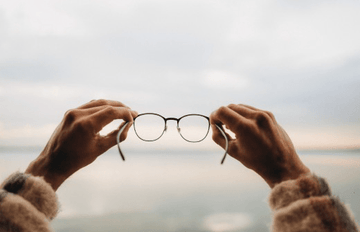The eyes may be the "window to the soul", but they are first of all our "window to the world". Sight is considered the most important of our five senses, as it is the way we perceive about 80% of all information from the world around us. [1] We thus rely on our eyes more than for example smell or hearing.
Unfortunately, the risk of developing eye diseases such as macular degeneration, cataracts and glaucoma increases with age. People with poor eyesight are more at risk of social isolation and health problems, and thus have a lower quality of life. Healthy eyes are therefore essential and need to be properly cared for. In this article you will find out what involves eye care in relation to nutrition and the use of digital technology.
Article at a glanc:
- Eye health in relation to digital technology use
- Eye problems related to aging
- Lifestyle and diet as a prevention against the eye problems
- Lifestyle measures that support healthy vision
Eye health in relation to digital technology use
Have you heard of "computer vision syndrome"?
Today a large number of people need only a computer for their work. The advantage is that they are able to work from almost anywhere: whether from home, a cozy café or even from a foreign country. However, working with a computer for a long time has its disadvantages including the so-called computer vision syndrome. This syndrome is caused by prolonged unilateral eye strain, when the eyes focus at a short distance for a long period of time. This results in excessive strain on the eye muscles. You can then experience typical symptoms including irritated, tired and dry eyes, blurred vision and often head, neck and back pain.
According to the U.S. National Institute for Health and Safety, up to 90% of people who spend at least three hours a day on a computer experience this syndrome. [2]
Digital technology and children
Today's children have easier access to digital technology than ever before. Even at a young age, they often have mobile phones and tablets to fill their free time. Logically, digital technologies are also being used more often in schools. The frequent use of computers and mobile phones, together with the fact that we spend more time in enclosed spaces with a lack of natural light, adversely affects eyesight and can contribute, for example, to myopia.
Eye problems related to aging
Deteriorating eyesight is one of the unpleasant consequences of aging. Impaired vision significantly affects the quality of life and the ability to function independently. Older adults with poor vision have also been shown to enter nursing homes approximately 3 years earlier, have twice the risk of falls and four times the risk of hip fractures. [3] The most common causes of visual impairment in adults include macular degeneration, cataracts, glaucoma and diabetic retinopathy.
- Macular degeneration
Macular degeneration is a serious eye disease that affects mainly the elderly. Age-related macular degeneration of the retina is the most common cause of sight loss in Europe. [4]
The disease may be subtle at first, with vision getting worse at dusk and in the dark. The first subjectively observable symptoms of age-related macular degeneration are blurred vision, gray areas in the central vision area, unusually blurred images or wavy, distorted lines and letters. People with this disability lose central vision (peripheral vision is preserved), resulting in an inability to recognize faces, details and colors. Other manifestations also include difficulty in determining distance and height. This gradually leads to an inability to carry out normal daily activities. People affected by macular degeneration eventually become dependent on the help of others.There are several proven risk factors that contribute to the development of this disease. These include advanced age, certain genetic variations, higher body mass index, smoking and excessive alcohol consumption. [5]
- Cataract
Cataract is a disease of the eye in which vision is impaired due to clouding of the lens. Cataracts are manifested by blurred, out-of-focus vision. It is most often caused by aging, when we speak of so-called senile cataracts.
- Glaucoma
It is also called the silent thief of sight because it develops slowly and manifests itself for a long time without any significant symptoms. Glaucoma affects the peripheral vision, initially there are small gaps in the field of vision, but later the person sees only shadows instead of objects or figures. Glaucoma leads to progressive damage to the optic nerve, resulting in partial or even complete loss of vision. Increased intraocular pressure can be the first warning sign, which is why it is important to have regular eye examinations by an eye specialist.
- Diabetic retinopathy
Diabetic retinopathy is a disease of the retina occurring in diabetes mellitus due to damage of blood vessels nourishing the retina. In severe cases, diabetic retinopathy leads to bleeding in the retina and vitreous, causing severe visual impairment and even blindness. The risk of developing this disease increases with the duration of diabetes or if blood glucose levels are not well regulated. Glycemia, normal blood pressure and regular eye examinations can significantly reduce the risk of developing this disease, but do not eliminate it. [6]
Lifestyle and diet as a prevention against the eye problems
Certain lifestyle and dietary measures can significantly reduce the risk of developing vision complications. These interventions include regular eye examinations by an ophthalmologist, avoidance of smoking, reduction of UV exposure, balanced glycaemia and, last but not least, a healthy and nutritious diet rich in phytonutrients.

Healthy diet and vision supplements
Many nutrients affect eye health and should be included in your diet regularly. Eating a plant-based diet rich in phytochemicals has been shown to be an important factor in maintaining visual acuity even in old age. According to various studies, certain vitamins and nutrients can prevent or slow down the risk of certain eye diseases such as age-related macular degeneration, glaucoma, diabetic retinopathy and cataracts.
Below are examples of several nutrients whose supplementation may be beneficial for vision support.
- Omega 3 fatty acids
Regular intake of omega-3 fatty acids may help protect against eye disease. The omega-3 fatty acid DHA is a structural component of the retina of the eye and is thus essential for healthy eye development. According to some studies, DHA may also help improve certain eye conditions such as dry eyes or diabetic retinopathy. [16]
A 2018 study [17] led to the finding that daily supplementation of omega-3 fatty acids for 3 months led to a reduction in intraocular pressure in normotensive adults. Elevated intraocular pressure is a risk factor for glaucoma. In several other studies, omega-3 fatty acid consumption has been shown to reduce the risk of macular degeneration. [18]
For example, a 5-year study [19] of 2335 adults aged 49 years and older reported that consuming fish 3 or more times per week was associated with a 75% reduction in the risk of macular degeneration compared to those consuming fish less than once per week.
- Vitamin C, vitamin E
The eye is particularly susceptible to oxidative stress and disruption of the delicate balance between free radicals and antioxidants. Restoring this balance with antioxidant vitamins E and C can reduce the risk of various eye defects such as retinopathy and cataracts.
Vitamin C is an important antioxidant that is found in the lens and intraocular fluid at more than 50 times the concentration found in blood plasma. [21] Vitamin C is essential for the synthesis of collagen, which also forms the structural protein in the eye. Some studies have reported that higher consumption of vitamins C and E is associated with a lower risk of many eye problems, especially cataracts [21] [22].
- Zinc
Zinc plays an important role in a number of physiological processes, including immunity or reproduction. Zinc concentrations are also high in the retina. [18][19] Several studies have found that higher intakes of zinc and vitamin E are associated with a lower incidence of macular degeneration or vision loss. [20]
- Lutein and zeaxanthin
These carotenoids are among the antioxidants that occur naturally as colored dyes in fruits and vegetables. Both of these carotenoids are found in the macula and retina and are part of the macular pigments of the retina. [13] Lutein and zeaxanthin help filter blue light and protect the eyes from free radical damage. [14]
However, it is not always necessary to take these carotenoids in the form of dietary supplements. As little as 6 mg of lutein a day may be enough to reduce the risk of macular degeneration. A diet rich in green leafy vegetables such as spinach, chard or kale naturally provides this amount. In addition, cooking these vegetables will increase the availability of available carotenoids. [15]
- Anthocyanins
Anthocyanins are plant pigments found in dark-coloured fruits and vegetables. They are abundant in berries such as blueberries, blackberries, blackcurrants and chokeberries. Wild blueberries are particularly rich in anthocyanins, which have historically been used to aid eyesight. During World War II, British Air Force pilots ate blueberry jam before night flights to improve their night vision. A particularly interesting anthocyanin found in blueberries is cyanidin-3-glucoside, or C3G. C3G stimulates the production of the pigment rhodopsin, which is found in the retina and is important for low-light vision. [23]
- Astaxanthin
Astaxanthin is a red pigment in the carotenoid family found in algae and some marine animals such as shrimp, lobster, and salmon. The efficacy of this carotenoid in certain eye diseases is supported by studies that highlight its effect in the prevention and treatment of certain eye diseases. [24]
Lifestyle measures that support healthy vision
- Eye examinations
Regular eye examinations can often detect eye defects early, which is essential for successful treatment. However, eye examinations can also highlight conditions such as diabetes mellitus or high blood pressure, as blood vessels in the eye can be observed non-invasively. It is important to remember that the need for preventive examinations increases after the age of 40.
- Maintaining balanced blood sugar levels
Whether a person has diabetes or not, controlling blood sugar levels and avoiding refined sugars are also essential for maintaining healthy eyes. Eating a diet with a higher glycemic index has been shown to increase the risk of cataracts, age-related macular degeneration and diabetic retinopathy. [7]
- Avoiding smoking and alcohol
Eye health is affected by a number of variables, and smoking is one of the most important risk factors contributing to ocular tissue damage. As mentioned above, smoking is associated with a significantly higher risk of macular degeneration and also contributes to cataract formation. [8] [9]
Excessive alcohol consumption also increases the risk of eye defects. A study of 20,963 adults aged 40-69 years reported that consuming more than 20 g of alcohol per day (approximately one to two drinks per day) was associated with a 20% risk increase of macular degeneration. [10]
- Wearing sunglasses
Protecting your eyes from excessive sunlight also plays a role in maintaining healthy vision. Wearing sunglasses can reduce the risk of developing macular degeneration or cataracts due to UV exposure. [11]
- Compensating the use of digital technologies
If we want to protect our eyes, it is not necessary to give up computer work completely. The way we use digital screens determines to a large extent whether vision problems occur or are prevented.
Below are some simple eye hygiene rules to help save your eyes:
- Screen placement
It is advisable to place the computer screen about 45 to 50 cm from the eyes, slightly below eye level. Sitting too close to the digital screen increases the risk of eye fatigue.
- Correct posture
Sitting up straight with your shoulders relaxed and your legs at roughly right angles to the floor is appropriate. Avoid bending your head and slouching. Ergonomic aids and furniture may also be helpful. Bear in mind that poor posture also strains the eyes.
- Blink often
Blinking helps your eyes stay lubricated and prevents irritation and dryness.
- Exercise your eye muscles
Eye muscles, like other muscles, need to be exercised. There are several ways to do this. You can opt for eye yoga or adopt a simple "rule of 20," after spending 20 minutes working on your computer, look at a distant object for 20 seconds and blink 20 times.
- Regular breaks
After two hours of computer work, let your eyes rest away from the computer for about 10 minutes. In the Czech Republic, according to Government Regulation workers are entitled to safety breaks of five to ten minutes after every two hours of continuous computer work.
- Spending time outdoors
Spending time in natural daylight and focusing the eyes on distant objects in the surroundings has a positive effect on the eyesight. So one of the most important pieces of advice is to spend more time outdoors.
Sources:
[1] https://cs.wikipedia.org/wiki/Zrak
[2]https://cs.wikipedia.org/wiki/Syndrom_po%C4%8D%C3%ADta%C4%8Dov%C3%A9ho_vid%C4%9Bn%C3%AD
[3] Eichenbaum JW. Geriatric vision loss due to cataracts, macular degeneration, and glaucoma. Mt Sinai J Med. 2012 Mar-Apr;79(2):276-94. doi: 10.1002/msj.21303. PMID: 22499498.
[4] Coleman HR, Chan CC, Ferris FL 3rd, Chew EY. Age-related macular degeneration. Lancet. 2008 Nov 22;372(9652):1835-45. doi: 10.1016/S0140-6736(08)61759-6. PMID: 19027484; PMCID: PMC2603424.
[5] Velilla S, García-Medina JJ, García-Layana A, Dolz-Marco R, Pons-Vázquez S, Pinazo-Durán MD, Gómez-Ulla F, Arévalo JF, Díaz-Llopis M, Gallego-Pinazo R. Smoking and age-related macular degeneration: review and update. J Ophthalmol. 2013;2013:895147. doi: 10.1155/2013/895147. Epub 2013 Dec 4. PMID: 24368940; PMCID: PMC3866712.
[6] https://nsc.uzis.cz/zdraveoci/index.php?pg=diabeticka-retinopatie
[7] Chiu CJ, Rabbani N, Rowan S, Chang ML, Sawyer S, Hu FB, Willett W, Thornalley PJ, Anwar A, Bar L, Kang JH, Taylor A. Studies of advanced glycation end products and oxidation biomarkers for type 2 diabetes. Biofactors. 2018 May;44(3):281-288. doi: 10.1002/biof.1423. Epub 2018 May 2. PMID: 29718545; PMCID: PMC8527553.
[8] Coleman AL, Seitzman RL, Cummings SR, Yu F, Cauley JA, Ensrud KE, Stone KL, Hochberg MC, Pedula KL, Thomas EL, Mangione CM; Study Of Osteoporotic Fractures Research Group. The association of smoking and alcohol use with age-related macular degeneration in the oldest old: the Study of Osteoporotic Fractures. Am J Ophthalmol. 2010 Jan;149(1):160-9. doi: 10.1016/j.ajo.2009.07.025. Epub 2009 Oct 1. PMID: 19796757; PMCID: PMC3068844.
[9] Lindblad BE, Håkansson N, Svensson H, Philipson B, Wolk A. Intensity of smoking and smoking cessation in relation to risk of cataract extraction: a prospective study of women. Am J Epidemiol. 2005 Jul 1;162(1):73-9. doi: 10.1093/aje/kwi168. PMID: 15961589.
[10] Adams MK, Chong EW, Williamson E, Aung KZ, Makeyeva GA, Giles GG, English DR, Hopper J, Guymer RH, Baird PN, Robman LD, Simpson JA. 20/20--Alcohol and age-related macular degeneration: the Melbourne Collaborative Cohort Study. Am J Epidemiol. 2012 Aug 15;176(4):289-98. doi: 10.1093/aje/kws004. Epub 2012 Jul 29. PMID: 22847604.
[11] Sui GY, Liu GC, Liu GY, Gao YY, Deng Y, Wang WY, Tong SH, Wang L. Is sunlight exposure a risk factor for age-related macular degeneration? A systematic review and meta-analysis. Br J Ophthalmol. 2013 Apr;97(4):389-94. doi: 10.1136/bjophthalmol-2012-302281. Epub 2012 Nov 10. PMID: 23143904.
[13] Eisenhauer B, Natoli S, Liew G, Flood VM. Lutein and Zeaxanthin-Food Sources, Bioavailability and Dietary Variety in Age-Related Macular Degeneration Protection. Nutrients. 2017 Feb 9;9(2):120. doi: 10.3390/nu9020120. PMID: 28208784; PMCID: PMC5331551.
[14] Kijlstra A, Tian Y, Kelly ER, Berendschot TT. Lutein: more than just a filter for blue light. Prog Retin Eye Res. 2012 Jul;31(4):303-15. doi: 10.1016/j.preteyeres.2012.03.002. Epub 2012 Mar 21. PMID: 22465791.
[15] Ranard KM, Jeon S, Mohn ES, Griffiths JC, Johnson EJ, Erdman JW Jr. Dietary guidance for lutein: consideration for intake recommendations is scientifically supported. Eur J Nutr. 2017 Dec;56(Suppl 3):37-42. doi: 10.1007/s00394-017-1580-2. PMID: 29149368; PMCID: PMC5715043.
[16] Kangari H, Eftekhari MH, Sardari S, Hashemi H, Salamzadeh J, Ghassemi-Broumand M, Khabazkhoob M. Short-term consumption of oral omega-3 and dry eye syndrome. Ophthalmology. 2013 Nov;120(11):2191-6. doi: 10.1016/j.ophtha.2013.04.006. Epub 2013 May 1. PMID: 23642375.
[17] Downie LE, Vingrys AJ. Oral Omega-3 Supplementation Lowers Intraocular Pressure in Normotensive Adults. Transl Vis Sci Technol. 2018 May 1;7(3):1. doi: 10.1167/tvst.7.3.1. PMID: 29736322; PMCID: PMC5931260.
[18] Weikel KA, Chiu CJ, Taylor A. Nutritional modulation of age-related macular degeneration. Mol Aspects Med. 2012 Aug;33(4):318-75. doi: 10.1016/j.mam.2012.03.005. Epub 2012 Apr 6. PMID: 22503690; PMCID: PMC3392439.
[19] Chua B, Flood V, Rochtchina E, Wang JJ, Smith W, Mitchell P. Dietary fatty acids and the 5-year incidence of age-related maculopathy. Arch Ophthalmol. 2006 Jul;124(7):981-6. doi: 10.1001/archopht.124.7.981. PMID: 16832021.
[20] Weikel 2012; van Leeuwen R, Boekhoorn S, Vingerling JR, Witteman JC, Klaver CC, Hofman A, de Jong PT. Dietary intake of antioxidants and risk of age-related macular degeneration. JAMA : the journal of the American Medical Association. Dec 28 2005;294(24):3101-3107.
[21] Weikel KA, Garber C, Baburins A, Taylor A. Nutritional modulation of cataract. Nutr Rev. 2014 Jan;72(1):30-47. doi: 10.1111/nure.12077. Epub 2013 Nov 26. PMID: 24279748; PMCID: PMC4097885.
[22] Chiu CJ, Taylor A. Nutritional antioxidants and age-related cataract and maculopathy. Exp Eye Res. 2007 Feb;84(2):229-45. doi: 10.1016/j.exer.2006.05.015. Epub 2006 Jul 31. PMID: 16879819.
[23] Nomi Y, Iwasaki-Kurashige K, Matsumoto H. Therapeutic Effects of Anthocyanins for Vision and Eye Health. Molecules. 2019 Sep 11;24(18):3311. doi: 10.3390/molecules24183311. PMID: 31514422; PMCID: PMC6767261.
[24] Giannaccare G, Pellegrini M, Senni C, Bernabei F, Scorcia V, Cicero AFG. Clinical Applications of Astaxanthin in the Treatment of Ocular Diseases: Emerging Insights. Mar Drugs. 2020 May 1;18(5):239. doi: 10.3390/md18050239. PMID: 32370045; PMCID: PMC7281326.

















